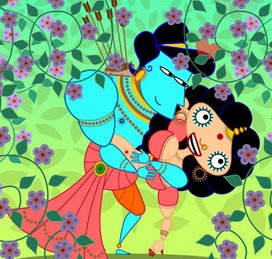
Stephen Parr continues to curate some of the most interesting programs in the Bay Area at his delightfully informal afficionado's salon Oddball Films. This last Friday I caught his "Night of Hell" Halloween offering, "an evening of apocalyptic mayhem" which showcased "cinematic scraps from the devil's junkyard", including rare exploitation horror shorts, idiotic Goth public access clips, San Francisco devil-worshipping cult icon Anton La Vey, teenage Super 8mm home movie monster films, and the gory Seytan (a Turkish Exorcist remake). The unquestioned gems, however, were a classic Scopitone of Joi Lansing singing "Web of Love", Serge Gainsborough singing, "Dr. Jekyll and Mr. Hyde", and the rare LSD: A Case Study, which proves once and for all that hotdogs and hallucinogens just don't mix!

This coming Saturday, November 4th at 8:00 PM I'm anticipating Oddball Films' presentation "Myth and Music—Sita Sings the Blues", a screening of Nina Paley's mythic, animated work-in-progress opus plus animated gems. Sita Sings the Blues is a unique combination of the ancient Indian epic Ramayana, the 1920's torch vocals of the great Annette Hanshaw, and classically informed and inventive, eye-popping animation.
Nina Paley admits the subject matter of Sita Sings the Blues is controversial: "While I've been greatly encouraged by the overwhelming positive response from desis (South Asian expatriates), some viewers in India have been outraged. The Ramayana is a perplexing tale, and Sita is its most misunderstood character. I've heard from more than one Hindu American woman that Sita Sings the Blues is the first Ramayana retelling that offers them a real connection to Sita. My retelling is also humorous, which some people interpret as irreverent, and therefore an affront. Not that this has any bearing on my work; as I learned from The Stork, the greater the risks in art, the greater the rewards. I have nothing but love and admiration for my source material now. I hope to show how the genius of The Ramayana transcends societies and generations, and is as relevant today as it was 3,000 years ago."

At the Sita Sings the Blues website you can view Quicktime clips of the first five chapters of Paley's work-in-progress, including Dandaka Dharma (with Hanshaw singing "Here We Are"), The Abduction of Sita (Hanshaw sings "What Wouldn't I Do For That Man?", Hanuman Finds Sita ("Daddy, Won't You Please Come Home?"), Battle of Lanka ("Who's That Knocking At My Door?") and Trial By Fire ("Mean To Me").
Relating the genesis of Sita Sings the Blues, Paley writes: "In June 2002 I moved to Trivandrum, India, following my (American) husband who had taken a job there. Upon my arrival I was confronted with his mid-life crisis, a complete emotional withdrawal. This left me without support in a city in which women were second-class citizens, unable to walk alone at night, and not expected to have an identity separate from their husbands. It was in Trivandrum I encountered the Indian epic, The Ramayana, for the first time. Like many westerners, I initially considered The Ramayana little more than misogynist propaganda. Meanwhile I was in the midst of developing a new comic strip for King Features Syndicate, The Hots. After three months in Trivandrum, King Features flew me to their New York headquarters for a launch meeting. Then my husband dumped me by email.
"Unable to return to my former apartment in San Francisco, or my new apartment in Trivandrum, I moved to Brooklyn. My professional life benefited, as I began teaching animation at Parsons School of Design and acquiring New York freelance clients. Emotionally, however, my relocation commenced a terrible year of grief. The Ramayana took on new depth and meaning for me.

"It no longer resembled a sexist parable; rather, it seemed to capture the essence of painful relationships, and describe a blueprint of human suffering. My grief and longing for the man who rejected me increasingly resembled Sita's; my husband's withdrawal reminded me of Rama. In Manhattan I heard the music of Annette Hanshaw for the first time. A radio star of the late 1920's, Hanshaw specialized in heartfelt blues and torch songs. In my grief-addled state, her songs, my story, and The Ramayana merged into one: Sita Sings the Blues.

"Originally, I hoped to expel my demons of heartbreak with a single short film, Trial By Fire (2003). This set a pivotal scene from The Ramayana, Sita's walk through a funeral pyre, to Annette Hanshaw's 1929 rendition of "Mean to Me." Trial By Fire won second Place in New York's 2004 ASIFA-East Animation Festival, and screened in festivals in San Francisco, Latvia, and Red Bank, but I refrained from promoting it further. Audiences loved the design and animation, but were not sufficiently familiar with The Ramayana to really understand the story. Furthermore, my demons weren't adequately expressed; I was still tormented by grief and heartache. When another relationship failed in November of 2004, I saw only one course of action: I had to tell the whole Ramayana story from Sita's point of view. Sita Sings the Blues, a 72-minute feature, would be my salvation.
"I began production in December 2004. In April 2005, a popular weblog called BoingBoing reported on my work-in-progress; within hours, thousands of viewers were downloading the movie clips I posted online, temporarily shutting down my web site. Reviews began appearing on hundreds of other weblogs, all positive. This was followed by print newspaper and magazine coverage in Switzerland, Korea, and India, as well as India Abroad in New York. Artwallah, Los Angeles' South Asian Arts Festival, solicited and screened a chapter called Dandaka Dharma, which also won an Excellence in Design award from ASIFA-East's 2005 festival."

Nina Paley's career began in 1988 with her self-syndicated comic strip, Nina's Adventures, which appeared in several alternative newspapers and two paperback collections, Depression is Fun and Nina's Adventures. She created two solo comic books for Dark Horse Comics, and various graphic short stories for Last Gasp Comix, Rip Off Press, Laugh Lines Press, Grateful Dead Comix, Kitchen Sink Press, and the Japanese artist volume Jarebong. Her first mainstream daily comic strip, Fluff, was distributed internationally by Universal Press Syndicate between 1995 and 1998; in 2002 she drew The Hots for King Features Syndicate.

Comics burn-out drove Nina to animation. Her first film, Luv Is... (1998), was clay stop-motion shot with a vintage super-8 camera. She went on to make three more films in 1998, each exploring a different medium or technique: Cancer (drawing and scratching on 35mm), I Heart My Cat (16mm stop-motion) and Follow Your Bliss (traditional pencil and ink on paper). In 1999 she made the world's first completely cameraless IMAX film, Pandorama, and received a grant from the Film Arts Foundation to produce Fetch! (2001), a short film incorporating optical illusions. In 2002 she created a controversial series about overpopulation and the environment, including The Stork, which won first prize at the EarthVision Environmental Film Festival and an unsolicited invitation to Sundance (2003). Cancer, Pandorama and Fetch! will be some of the additional animated shorts included in the Oddball Films program.
In addition to making independent animated festival films, Nina teaches at Parsons School of Design in Manhattan. She lives in New York with her cat, Bruno.

Oddball Films is located at 275 Capp St. Info and reservations at info@oddballfilm.com or 415-558-8117. Admission is $10.00 (Limited Seating RSVP Preferred).
"That's all!"